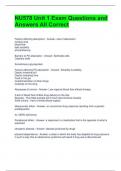Exam (elaborations)
NU578 Unit 1 Exam Questions and Answers All Correct
- Course
- Institution
NU578 Unit 1 Exam Questions and Answers All Correct Factors affecting absorption - Answer- rate of dissolution surface area blood flow lipid solubility pH partitioning Barriers to PO absorption - Answer- Epithelial cells Capillary walls Sometimes p-glycoprotein Factors affecting P...
[Show more]



